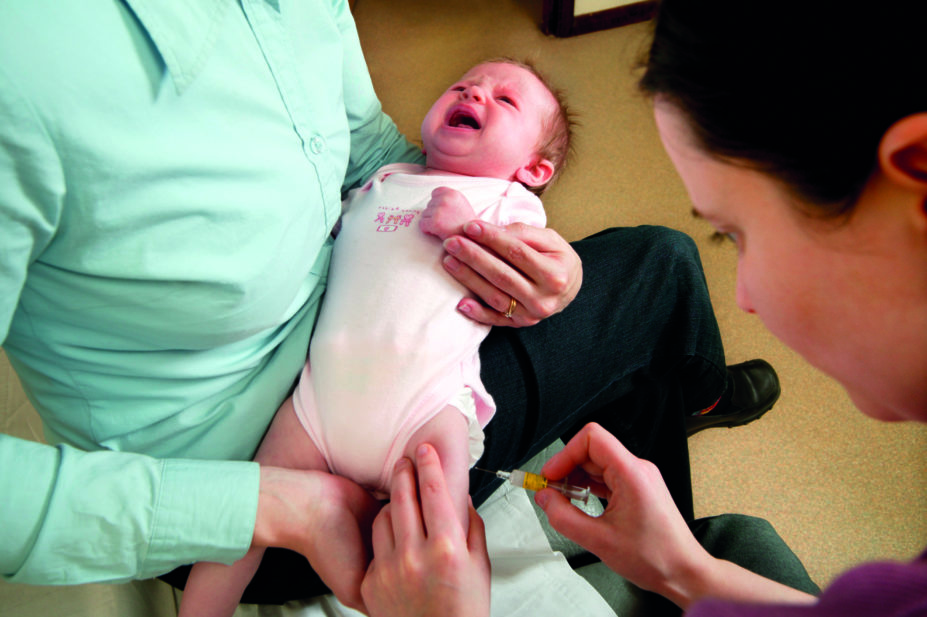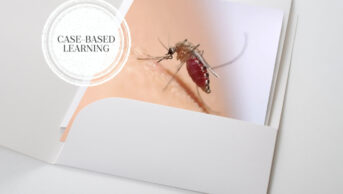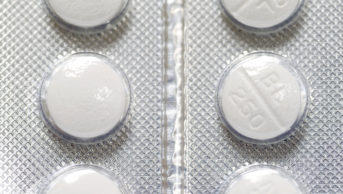
Samuel Ashfield / Science Photo Library
Whooping cough (also called pertussis after its causative agent) is a resurgent disease in the UK. A significant increase in observed cases nationally during 2011 led to the declaration of a national outbreak in April 2012[1]
. In 2012, there were 9,367 confirmed cases in England, a ten-fold increase on previous years[2]
. Historically, despite its very high transmissibility, pertussis has been well controlled since the routine introduction of acellular vaccination in 2004, during a period of sustained high vaccine coverage[3]
. There were previous, large epidemics in the 1970s and 1980s owing to drops in vaccine coverage over safety concerns of the previously used whole-cell pertussis vaccine that was introduced in 1952. The recent national increase in observed cases is not unique to the UK and is thought to be partly because of the change in vaccine; acellular versions afford a shorter duration of protection, with less protection again colonisation and, therefore, transmission of bacteria[4]
. Acellular vaccines remain highly effective against infection and severe disease.
Patients infected with the causative agent of whooping cough, Bordetella pertussis, suffer from a prolonged cough illness without fever. Characteristically an illness of older children and adults, it can affect patients of all age groups with severe disease, which includes apnoeic episodes, pneumonia and neurological complications more common in young children, often with high mortality if left untreated. The classic inspiratory ‘whoop’ follows paroxysms of coughing, which begins at week 1–2 of illness and increases throughout the 1–2 months of illness following a 9–10 day incubation[5]
(see Box 1: Clinical symptoms of whooping cough).
Box 1: Clinical symptoms of whooping cough
Whooping cough has three phases of symptoms:
- 1. The catarrhal phase (lasts around one week)
- Runny nose.
- Conjunctivitis.
- Sore throat.
- Sneezing.
- Slightly raised temperature.
- 2. The paroxysmal phase
(occurs around one week after catarrhal phase)- Intense coughing fits (paroxysms), which tend to last a few minutes at a time and are more common at night. Paroxysms consist of a short expiratory burst followed by an inspiratory gasp (the ‘whoop’ sound). The ‘whoop’ is less common in adults and in children aged younger than three months.
- Coughing can bring up mucus and may be followed by vomiting.
- If severe enough, young children may briefly turn blue (cyanosis) if they have trouble breathing because of mucus plugging their airways.
- 3. The convalescent phase
(lasts up to three months)- The paroxysms will become less severe and less frequent.
UK maternal pertussis vaccination programme
The main aim of the maternal vaccination programme is to boost maternal immunity and optimise the transplacental transfer of maternal pertussis antibodies, so that the neonate has some immunity from birth until they are two months old, when they receive their first pertussis-containing vaccine during their primary immunisation course.
Since the programme’s launch in October 2012 as an outbreak response measure, a pertussis vaccination has been offered to all pregnant women, ideally from 28 to 32 weeks of pregnancy[6]
; this was revised in April 2016 to earlier in pregnancy (from 16 weeks gestation onwards) in order to provide more vaccination opportunities[7]
. The emergency vaccination programme was extended in July 2014 to continue for a further five years based on evidence of the safety and high effectiveness of the programme, with the next evaluation tabled for summer 2019[8]
.
Since the programme was introduced, there have been 18 deaths in babies from B. pertussis, all born to unvaccinated mothers or those vaccinated immediately before delivery; it takes approximately two weeks for antibody levels to rise[2],[9]
. Annual cases in England have dropped to 4,191 and 5,945 in 2015 and 2016, respectively, although pertussis is cyclical with peaks every three or four years[9]
. The programme has been estimated to be highly effective, preventing over ten years an estimated 1,650 infant hospitalisations, including 55–60 infant deaths, and 20,500 maternal cases, of which 1,800 would be severe. However, the overall cost-effectiveness of the programme will depend on future pertussis incidence[10]
. Recent studies highlight that the vaccine effectiveness of both the UK and United States maternal programmes are above 90%[11],[12]
.
Maternal immunisation is safe: a review of more than 18,000 vaccinated women in the UK showed no increased risk of adverse pregnancy outcomes, birth complications or time to delivery compared with historical and unvaccinated controls[13]
. One of the potential concerns has been the demonstrated ‘blunting’ in pertussis antibody response to the infants born to vaccinated mothers, although, to date, there has been no translation to any increased risk of disease. Assessing the clinical significance of these findings is challenging given the lack of an agreed correlate of protection. There is also some evidence to indicate an enhancement of the response to tetanus and tetanus-conjugated vaccines, and a decline in response to diphtheria and diphtheria CRM-conjugated vaccines[14],[15],[16],[17],[18]
.
National guidelines for vulnerable groups
In late 2016, the national guidelines for the public health management of pertussis in England were updated to reflect how the ‘vulnerable groups’ have changed following evidence of the high effectiveness of the maternal vaccination programme[19]
(see Box 2: Vulnerable groups at increased risk of severe or complicated pertussis).
Box 2: Vulnerable groups at increased risk of severe or complicated pertussis
Previously, any child aged under one year who had not completed their primary vaccination programme was considered ‘vulnerable’. In the updated Public Health England guidance, vulnerable infants are now defined according to maternal vaccination, prematurity and age, owing to the limited impact of chemoprophylaxis in the context of high levels of protection conferred through maternal vaccination.
- Any child (born < 32 weeks) aged less than two months, regardless of maternal vaccination status.
- Any child (born >32 weeks) aged less than two months whose mother was unvaccinated.
- Any child aged over two months who is unvaccinated or partially vaccinated (regardless of maternal vaccination status), is considered vulnerable.
Source: Amirthalingam G, The Pertussis Guidelines Group. Guidelines for the Public Health Management of Pertussis in England. Public Health England: London, 2016.
Methods for diagnosis
There are a variety of modalities for pertussis diagnosis depending on the duration of symptoms at presentation and age of the patient.
Polymerase chain reaction (PCR) testing has been rolled out to all Public Health England (PHE) regional laboratories, and has been offered to all age groups (previously only for hospitalised infants aged under one year) since July 2014. PCR is recommended for patients who have only been symptomatic for less than three weeks. Routine culture on special media is available through certain NHS and private laboratories (also for those whose symptoms are present for three weeks or less). Serum samples sent for serology will detect antibodies in patients symptomatic for two weeks or more and are ideal for older children, adults and those presenting later in illness. Oral fluid kits are available from local health protection teams and are aimed at children aged 5–16 years to increase diagnosis in this age group[19]
.
All suspected cases should be notified to health protection teams before laboratory confirmation.
Vaccines
The UK immunisation schedule contains four doses of pertussis-containing vaccine in childhood, with an accelerated schedule at ages two, three and four months, and a pre-school booster at three years, four months old or shortly after. It does not recommend routine further doses after age ten in individuals who are incompletely immunised, apart from in outbreak scenarios[7]
. The updated recommended groups for post-exposure vaccination are detailed in Table 1. The rationale is to protect vulnerable infants, via those who come into regular contact with them, against any future exposure — this includes close contacts aged over ten years who have not received a pertussis-containing vaccination in the past five years. Children aged under ten years should complete their primary and booster vaccinations as appropriate[19]
.
| Table 1: Groups requiring post-exposure vaccination | |
|---|---|
| Requires post-exposure vaccination | Does not require post-exposure vaccination |
| Unvaccinated mothers exposed after 32 weeks of gestation | Mothers vaccinated earlier in gestation through the maternity programme |
| All close family over the age of ten who have not received a pertussis-containing vaccination in the past five years or a DtIP* | Babies aged under two months who should complete their primary immunisation schedule |
| *Diphtheria, tetanus and inactivated polio vaccine | |
For maternal pertussis immunisation in the UK national programme, there are two licensed vaccines. Both are acellular pertussis preparations with low-dose diphtheria toxoid, tetanus toxoid and inactivated polio: Repevax® and Boostrix®-IPV. The former was used in the maternal vaccination programme until July 2014, when it switched to Boostrix®-IPV. Despite the switch in vaccine to one with a higher antigen content but fewer antigens (from five to three), overall vaccine effectiveness was maintained at over 90% in the three years following its introduction for laboratory-confirmed pertussis[20],[21],[22]
.
For infant vaccination, since switching to acellular vaccines in the primary immunisation schedule in 2004, Pediacel® and Infanrix®-IPV+Hib have been used. Both vaccines include diphtheria, tetanus, acellular pertussis, inactivated polio and haemophilus type b conjugates. Pediacel® contains five pertussis components, whereas Infanrix®-IPV+Hib contains three[23]
. They are given to babies at the ages of two, three and four months. From summer 2017, the UK will move to vaccinating infants with Infanrix®-hexa, which will also include protection against hepatitis B[24]
.
Antimicrobial therapy
Reviews have shown that treatment of pertussis offers little advantage in terms of disease length but should be considered to prevent the spread of B. pertussis to vulnerable contacts who may not have been immunised[25]
. Treatment is most effective when started within 7–14 days of symptom onset but this can be tricky if patients do not present early in their symptom course or there are delays in diagnosis. One UK review stated that there is no evidence of benefit from chemoprophylaxis after 21 days of symptom onset[26]
, with no statistically significant difference in contacts that become culture positive after pertussis exposure when treated with antibiotic chemoprophylaxis[27]
.
The UK guidelines are conservative in the approach to chemoprophylaxis compared with the United States[28]
, because evidence of efficacy is limited. Furthermore, given the high effectiveness of the maternal immunisation programme, chemoprophylaxis for infants born to vaccinated mothers is unlikely to confer any significant additional protection in the event of an exposure over and above passive protection.
Chemoprophylaxis and treatment of pertussis can prove challenging in women in the first trimester of pregnancy because they can only be prescribed erythromycin, which has been associated with infantile hypertrophic pyloric stenosis, a type of gastric outlet obstruction[29],[30],[31]
. This has been the subject of significant debate[32],[33]
, but the decision to prescribe erythromycin for women in the earlier stages of pregnancy should be clinician-led, based on the likely clinical benefit to the mother and any vulnerable close contacts.
Pregnant women in the third trimester who have been exposed to the disease, but have received a pertussis-containing vaccine between one week and five years ago, do not require chemoprophylaxis.
Within the new PHE guidelines[19]
, the guidelines for chemoprophylaxis have not changed greatly from previous versions (Table 2). Treatment options still include azithromycin, erythromycin, clarithromycin (preferred in neonates) and co-trimoxazole for those unable to have a macrolide. All strains of B. pertussis cultured in the UK are still fully sensitive to treatment but resistance has been noted in the United States, Taiwan and France[34]
.
| Table 2: Recommended antibiotic therapy | ||||
|---|---|---|---|---|
| Age group | Clarithromycin | Azithromycin | Erythromycin ≠| Co-trimoxazole *1 |
| Neonates (<1 month) | Preferred in neonates 7.5mg/kg twice a day for 7 days | 10mg/kg once a day for 3 days | Not recommended due to association with hypertrophic pyloric stenosis | Not licensed for infants <6 weeks |
Infants (1–12 months) & children (>12 months) | 1 month– 11 years: Under 8kg 7.5mg/kg twice a day for 7 days 8 12 20 30
12 500mg twice a day for 7 days | 1
> 6 months:10mg/kg (max 500mg) once a day for 3 days | 1
2
8
(doses can be doubled in severe infections) | 6 weeks
6 months
6
12 |
| Adults | 500mg twice a day for 7 days | 500mg once a day for 3 days | 500mg every 6 hours for 7 days | 960mg twice a day for 7 days |
| Pregnant women2 | Not recommended | Not recommended | Preferred antibiotic – not known to be harmful | Contraindicated in pregnancy |
1 Consider if macrolides contra-indicated or not tolerated. 2 For pregnant contacts, a risk assessment would need to be done to look at the risk and benefits of antibiotic therapy/prophylaxis. The aim of treating/prophylaxing women in pregnancy is to prevent transmission to the newborn infant, and should be considered in those who have not received a pertussis-containing vaccine more than one week and less than five years before. Where possible, pregnant women should begin treatment at least three days before delivery. ≠Doses can be doubled in severe infections. *Please note that the doses for treatment and prophylaxis are the same. | ||||
Although pertussis is still circulating at levels much higher than was seen pre-2012, the maternal vaccination programme has had significant impact on disease presentation in the most vulnerable infants. The programme will be evaluated in 2019 to determine whether it will be continued. Although post-exposure vaccination and antibiotic prophylaxis are offered to vulnerable contacts (or those who are exposed to them), the most effective intervention mainstay is pre-exposure vaccination.
Reading this article counts towards your CPD
You can use the following forms to record your learning and action points from this article from Pharmaceutical Journal Publications.
Your CPD module results are stored against your account here at The Pharmaceutical Journal. You must be registered and logged into the site to do this. To review your module results, go to the ‘My Account’ tab and then ‘My CPD’.
Any training, learning or development activities that you undertake for CPD can also be recorded as evidence as part of your RPS Faculty practice-based portfolio when preparing for Faculty membership. To start your RPS Faculty journey today, access the portfolio and tools at www.rpharms.com/Faculty
If your learning was planned in advance, please click:
If your learning was spontaneous, please click:
References
[1] Amirthalingam G, Gupta S & Campbell H. Pertussis immunisation and control in England and Wales, 1957 to 2012: a historical review. Euro Surveill 2013;18(38):20587. doi: 10.2807/1560-7917.ES2013.18.38.20587
[2] Vaccine Knowledge Project. Pertussis (whooping cough) vaccine in pregnancy. University of Oxford. 2017. Available at: http://vk.ovg.ox.ac.uk/pertussis-vaccine-in-pregnancy (accessed May 2017)
[3] Hodder SL & Mortimer EA. Epidemiology of pertussis and reactions to pertussis vaccine. Epidemiol Rev 1992;14:243–267. PMID: 1289114
[4] World Health Organization. Revised guidance on the choice of pertussis vaccines: July 2014. Wkly Epidemiol Rec 2014;30(89):337–344. PMID: 25072068
[5] Heymann D. Pertussis. In: control of communicable diseases manual 18th edition. Washington DC: American Public Health Association; 2004; 436–441.
[6] Department of Health. Whooping cough vaccination programme for pregnant women. DH, London, 2012. Available at: https://www.gov.uk/government/publications/whooping-cough-vaccination-programme-for-pregnant-women (accessed May 2017)
[7] Public Health England (PHE). Immunisation against infectious disease, Chapter 24 – “Pertussis”. PHE: London, 2016. Available at: https://www.gov.uk/government/uploads/system/uploads/attachment_data/file/514363/Pertussis_Green_Book_Chapter_24_Ap2016.pdf (accessed May 2017)
[8] Department of Health, Public Health England. Continuation of whooping cough vaccination programme in pregnancy advised. DH/PHE: London, 2014. Available at: https://www.gov.uk/government/news/continuation-of-whooping-cough-vaccination-programme-in-pregnancy-advised (accessed May 2017)
[9] Public Health England. Laboratory confirmed cases of pertussis reported to the enhanced pertussis surveillance programme in England: annual report for 2016. PHE: London; 2017. Available at: https://www.gov.uk/government/uploads/system/uploads/attachment_data/file/602950/hpr1217_prtsss_ann.pdf (accessed May 2017)
[10] van Hoek AJ, Campbell H, Amirthalingam G et al. Cost-effectiveness and programmatic benefits of maternal vaccination against pertussis in England. J Infect 2016;73(1):28–37. doi: 10.1016/j.jinf.2016.04.012
[11] Winter K, Cherry JD & Harriman K. Effectiveness of prenatal tetanus, diphtheria, and acellular pertussis vaccination on pertussis severity in infants. Clin Infect Dis 2017;64(1):9–14. doi: 10.1093/cid/ciw633
[12] Baxter R, Bartlett J, Fireman B et al. Effectiveness of vaccination during pregnancy to prevent infant pertussis. Pediatrics. 2017;epub ahead of print. doi: 10.1542/peds.2016-4091
[13] Donegan K, King B & Bryan P. Safety of pertussis vaccination in pregnant women in UK: observational study. BMJ 2014;349:g4219. doi: 10.1136/bmj.g4219
[14] Hardy-Fairbanks AJ, Pan SJ, Decker MD et al. Immune Responses in infants whose mothers received tdap vaccine during pregnancy. Pediatr Infect Dis J 2013;32(11):1257–1260. doi: 10.1097/INF.0b013e3182a09b6a
[15] Ladhani SN, Andrews NJ, Southern J et al. Antibody responses after primary immunization in infants born to women receiving a pertussis-containing vaccine during pregnancy: single arm observational study with a historical comparator. Clin Infect Dis 2015;61(11):1637–1644. doi: 10.1093/cid/civ69
[16] Hoang HTT, Leuridan E, Maertens K et al. Pertussis vaccination during pregnancy in Vietnam: results of a randomized controlled trial pertussis vaccination during pregnancy. Vaccine 2016;34(1):151–159. doi: 10.1016/j.vaccine.2015.10.098
[17] Maertens K, Hoang HTT, Nguyen TD et al. The effect of maternal pertussis immunization on infant vaccine responses to a booster pertussis-containing vaccine in Vietnam. Clin Infect Dis 2016;63(suppl 4):S197–204. doi: 10.1093/cid/ciw551
[18] Munoz FM, Bond NH, Maccato M et al. Safety and immunogenicity of tetanus diphtheria and acellular pertussis (tdap) immunization during pregnancy in mothers and infants. JAMA 2014;311(17):1760. doi: 10.1001/jama.2014.3633
[19] Amirthalingam G, The Pertussis Guidelines Group. Guidelines for the public health management of pertussis in England. PHE: London, 2016. Available at: https://www.gov.uk/government/uploads/system/uploads/attachment_data/file/576061/Guidelines_for_the_Public_Health_Management_of_Pertussis_in_England.pdf (accessed May 2017)
[20] Amirthalingam G, Campbell H, Ribeiro S et al. Sustained effectiveness of the maternal pertussis immunization program in England 3 years following introduction. Clin Infect Dis 2016;63(suppl 4):S236–243. doi: 10.1093/cid/ciw559
[21] Dabrera G, Amirthalingam G, Andrews N et al. A case-control study to estimate the effectiveness of maternal pertussis vaccination in protecting newborn infants in England and Wales, 2012–2013. Clin Infect Dis 2015;60(3):333–337. doi: 10.1093/cid/ciu821
[22] Amirthalingam G, Andrews N, Campbell H et al. Effectiveness of maternal pertussis vaccination in England: an observational study. Lancet 2014;384(9953):1521–1528. doi: 10.1016/S0140-6736(14)60686-3
[23] Public Health England. Use of Infanrix®-IPV+Hib in the infant schedule: information for healthcare professionals. PHE: London, 2014. Available at: https://www.gov.uk/government/uploads/system/uploads/attachment_data/file/417203/Infanrix-IPV-Hib_information_for_healthcare_professionals_March_2015__3__CT.pdf (accessed May 2017)
[24] Johnson L & Ladhani S. Hepatitis B vaccination in infants (Infanrix). Clinical Trials: Washington DC, 2017. Available at: https://clinicaltrials.gov/ct2/show/NCT01896596?term=Infanrix&rank=3 (accessed May 2017)
[25] Altunaiji S, Kukuruzovic R, Curtis N et al. Antibiotics for whooping cough (pertussis). Cochrane database Syst Rev 2007;(3):CD004404. doi: 10.1002/14651858.CD004404.pub3
[26] Dodhia H & Miller E. Review of the evidence for the use of erythromycin in the management of persons exposed to pertussis. Epidemiol Infect 1998;120(2):143–149. PMID: 9593483
[27] Halperin SA, Bortolussi R, Langley JM et al. A randomized, placebo-controlled trial of erythromycin estolate chemoprophylaxis for household contacts of children with culture-positive bordetella pertussis infection. Pediatrics 1999;104(4):e42. PMID: 10506267
[28] American Academy of Pediatrics Committee on Infectious Disease. Pertussis. In: Kimberlin D, Brady M, Jackson M, Long S, editors. Red Book®: 2015 Report of the Committee on Infectious Diseases, 30th Edition. 30th ed. Elk Grove Village, IL: AAPCID, 2015.
[29] Mahon BE, Rosenman MB & Kleiman MB. Maternal and infant use of erythromycin and other macrolide antibiotics as risk factors for infantile hypertrophic pyloric stenosis. J Pediatr 2001;139(3):380–384. doi: 10.1067/mpd.2001.117577
[30] Louik C, Werler MM & Mitchell AA. Erythromycin use during pregnancy in relation to pyloric stenosis. Am J Obstet Gynecol 2002;186(2):288–290. doi: 10.1067/mob.2002.119718
[31] Cooper WO, Ray WA & Griffin MR. Prenatal prescription of macrolide antibiotics and infantile hypertrophic pyloric stenosis. Obstet Gynecol 2002;100(1):101–106. PMID: 12100810
[32] Murchison L, De Coppi P & Eaton S. Postnatal erythromycin exposure and risk of infantile hypertrophic pyloric stenosis: a systematic review and meta-analysis. Pediatr Surg Int 2016;32(12):1147–1152. doi: 10.1007/s00383-016-3971-5
[33] Ericson JE, Arnold C, Cheeseman J et al. Use and safety of erythromycin and metoclopramide in hospitalized infants. J Pediatr Gastroenterol Nutr 2015;61(3):334–339. doi: 10.1097/MPG.0000000000000792
[34] Guillot S, Descours G, Gillet Y, et al. Macrolide-resistant Bordetella pertussis infection in newborn girl, France. Emerg Infect Dis 2012;18(6):966–968. doi: 10.3201/eid1806.120091


